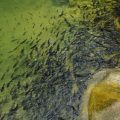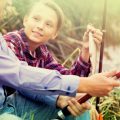Introduction to Thermoclines
If you’ve ever spent time fishing or boating on a North American lake or reservoir, you may have heard anglers talk about “the thermocline.” But what exactly is a thermocline, and why does it matter for fish behavior? In simple terms, a thermocline is a distinct temperature boundary that forms between layers of water at different temperatures. This phenomenon is especially common in lakes and reservoirs during the warmer months, when sunlight warms the upper layer of water much faster than the deeper layers. As a result, the warmer, lighter surface water sits above cooler, denser water below, creating a rapid change in temperature—this is the thermocline. Understanding how these layers form and shift throughout the season is essential for anyone interested in freshwater ecosystems, as well as for anglers hoping to locate fish more effectively. The unique conditions created by thermoclines play a significant role in shaping where fish live and feed within North America’s diverse lakes and reservoirs.
2. Physical Properties and Seasonal Changes
Thermoclines are not static features in lakes and reservoirs; they develop and change throughout the year due to shifting weather patterns, water temperature, and other environmental factors. Understanding these physical changes is crucial for anglers, biologists, and anyone interested in aquatic ecosystems.
How Thermoclines Develop
During late spring and early summer, as the sun warms the surface of a lake or reservoir, the water begins to separate into distinct layers. The uppermost layer, known as the epilimnion, is warmed by sunlight and wind mixing. Below this lies the thermocline—a transition zone where water temperature drops rapidly with increasing depth. Beneath the thermocline is the hypolimnion, a colder and denser layer that remains largely unaffected by surface conditions.
Seasonal Shifts in Thermocline Depth
The position and strength of the thermocline are closely linked to seasonal weather patterns:
| Season | Thermocline Development | Main Influencing Factors |
|---|---|---|
| Spring | Begins to form as surface warms; usually shallow | Increasing daylight, warming air temperatures |
| Summer | Well-established; typically deeper and more stable | Sustained heat, calm winds, less mixing |
| Fall | Dissipates as surface cools; mixing increases | Cooling temperatures, stronger winds, turnover events |
| Winter (in ice-covered lakes) | No distinct thermocline; water may stratify under ice differently | Ice cover reduces mixing, stable cold temperatures |
Factors Affecting Thermocline Strength and Depth
The development and stability of a thermocline depend on several variables:
- Lake Size and Shape: Larger, deeper lakes tend to have more pronounced and stable thermoclines than smaller or shallower bodies of water.
- Wind Action: Strong winds can disrupt thermal layering by mixing the water column, especially in shallow lakes or during stormy periods.
- Water Clarity: Clearer water allows sunlight to penetrate deeper, which can push the thermocline further down.
- Air Temperature Fluctuations: Rapid changes in air temperature can speed up or slow down thermocline formation.
- Geographical Location: Northern lakes often have shorter stratification periods compared to southern lakes due to shorter warm seasons.
The Takeaway for Anglers and Lake Managers
The dynamic nature of thermoclines means that understanding their seasonal behavior is essential when predicting fish activity or managing lake health. By monitoring temperature profiles throughout the year, you can anticipate where fish might concentrate and how oxygen levels may shift within different zones of the water column.

3. Thermoclines and Oxygen Levels
Thermoclines don’t just separate layers of water by temperature—they also play a major role in how dissolved oxygen is distributed within a lake or reservoir. As surface water heats up, it becomes less dense and tends to stay on top, while the cooler, denser water settles below the thermocline. This layering effect limits the mixing of oxygen-rich surface water with deeper layers. Over time, the oxygen content below the thermocline can drop dramatically, especially during the summer months when decomposition of organic matter increases oxygen consumption.
For fish, this creates a unique challenge. Many species require certain levels of dissolved oxygen to survive and thrive. When oxygen drops too low below the thermocline—a situation called hypoxia—fish are forced to move upwards, even if the temperature isn’t ideal for them. That’s why you’ll often find game fish like bass or walleye holding near the thermocline itself: it’s a sweet spot where water is cool enough for comfort but still contains enough oxygen for respiration.
Understanding this relationship helps anglers predict where fish are likely to be found during different seasons. For example, in late summer, you might notice that fish cluster just above the thermocline because it’s the only layer offering both tolerable temperatures and sufficient oxygen. On the other hand, in spring or fall when lakes “turn over” and layers mix, dissolved oxygen is more evenly distributed, and fish can roam more freely throughout the water column.
4. Fish Behavior and Thermocline Positioning
Thermoclines play a crucial role in shaping the behavior of freshwater fish in lakes and reservoirs. Different species respond uniquely to these temperature boundaries, adapting their migration patterns, feeding habits, and comfort zones throughout the seasons.
Species-Specific Responses to Thermoclines
Fish are ectothermic, meaning their body temperature closely matches that of their surroundings. As a result, they seek out layers within the water column that offer optimal conditions for survival and feeding. Below is a table outlining how some common North American freshwater species interact with thermocline boundaries:
| Species | Preferred Thermocline Zone | Behavioral Adaptation | Feeding Patterns |
|---|---|---|---|
| Largemouth Bass | Just above or within thermocline | Migrates vertically to find comfort; avoids cold hypolimnion | Active feeding at dawn/dusk near thermocline edge |
| Walleye | Lower metalimnion (thermocline layer) | Stays close to cooler layers for oxygen and prey access | Feeds along drop-offs where baitfish gather near thermocline |
| Trout (e.g., Rainbow Trout) | Below or within thermocline during summer | Seeks cooler, oxygen-rich water for comfort | Pursues prey in deeper zones as surface warms |
| Panfish (e.g., Bluegill) | Above thermocline in warm epilimnion | Avoids cold water; stays where food is abundant and temps are moderate | Feeds primarily in upper layers, especially during warm months |
| Northern Pike | Near thermocline but often ventures into shallows to hunt | Makes short forays between layers based on prey movement | Tends to ambush prey at thermocline breaks or weed edges |
Migration and Comfort Zones Across Seasons
The position of the thermocline shifts with seasonal changes, prompting fish to migrate vertically or horizontally. In summer, as surface temperatures rise and the thermocline deepens, many species retreat to cooler, oxygenated waters below or near the thermocline. Conversely, during spring and fall turnovers—when the water column mixes—fish become more evenly distributed as thermal barriers temporarily disappear.
Key Takeaways on Thermocline Influence:
- Largemouth bass and panfish: Prefer warmer upper layers but will approach the thermocline when seeking food or relief from surface heat.
- Trout and walleye: Depend on the stability of the thermocline for both comfort and access to prey.
- Northern pike: Use the thermocline as a hunting ground but remain flexible, crossing boundaries when necessary.
Understanding these behavioral patterns not only helps anglers target specific species more effectively but also provides valuable insights into lake ecology and fish health management strategies.
5. Implications for Anglers
Understanding how thermoclines affect fish behavior is a game-changer for American anglers targeting lakes and reservoirs. The thermocline, that distinct layer where water temperature shifts rapidly, often determines where the majority of active fish will be found—especially during summer months. To maximize your chances on the water, here’s how to use this knowledge to your advantage with modern fishing technology and some local smarts.
Leverage Modern Electronics
Todays fish finders and sonar units are invaluable tools when it comes to locating the thermocline. Most advanced models can visually display the depth where the water temperature changes most abruptly. Watch for a fuzzy or cloudy line on your screen—this is typically the thermocline. Once you spot it, focus your efforts just above or within this zone, as many species like bass, walleye, and trout tend to hold there for optimal oxygen and temperature conditions.
Tip:
If your electronics have a temperature sensor, do a slow vertical drop with your probe to pinpoint exactly where the water cools off. Set waypoints on your GPS at productive thermocline depths around structure or drop-offs.
Use Local Knowledge
No technology beats good old-fashioned advice from locals. Check with nearby bait shops or talk to seasoned anglers about typical thermocline depths in the lake or reservoir you’re fishing. Many bodies of water develop predictable patterns year after year, so tapping into this community wisdom can put you on fish faster than guesswork alone.
Tip:
Ask about recent weather trends—long heat waves can deepen the thermocline, while cold snaps may bring it up. Knowing these shifts helps you adapt quickly on game day.
Adapt Your Tactics
Once you’ve located the thermocline, adjust your lure presentations and trolling passes to target this depth specifically. Use downriggers, slip bobbers, or weighted rigs to keep your bait in the strike zone. During midday heat when fish retreat deeper, staying right at or just above the thermocline can make all the difference between a slow day and a successful one.
Tip:
If you’re fishing unfamiliar waters, start by scanning for the thermocline then fan out from nearby structure—points, humps, submerged timber—at that depth range. This methodical approach consistently produces results across American lakes and reservoirs.
6. Research and Conservation Considerations
Understanding how thermoclines influence fish behavior has become a significant focus for researchers and conservationists across the United States. Ongoing studies are exploring the complex interactions between thermal stratification, climate change, and fish populations in both natural lakes and man-made reservoirs. As climate change leads to warmer surface waters and potentially alters the depth and stability of thermoclines, scientists are concerned about shifts in fish distribution, feeding patterns, and spawning success.
Many U.S.-based research initiatives now use high-resolution temperature sensors, underwater drones, and advanced modeling techniques to monitor seasonal thermocline changes. These studies help reveal how native species like walleye, bass, trout, and even invasive species respond to fluctuating thermal layers. For example, fisheries biologists working in the Great Lakes region track how warming trends are impacting cold-water fisheries that rely on stable thermoclines during summer months.
Conservation efforts increasingly focus on protecting critical habitats affected by changing thermal structures. Agencies such as the U.S. Fish & Wildlife Service and various state departments collaborate with universities to map vulnerable zones where fish may face oxygen shortages or heightened competition due to compressed habitable areas above or below the thermocline.
Restoration projects may include managing water inflows, preserving shoreline vegetation for shade, or adjusting reservoir operations to support more natural temperature gradients. Anglers and local communities are also encouraged to participate in citizen science programs that collect water temperature data—helping to inform adaptive management strategies on a lake-by-lake basis.
As our understanding of thermoclines deepens, ongoing collaboration between researchers, conservationists, policymakers, and recreational users is key to ensuring healthy fish populations in America’s lakes and reservoirs for generations to come.

